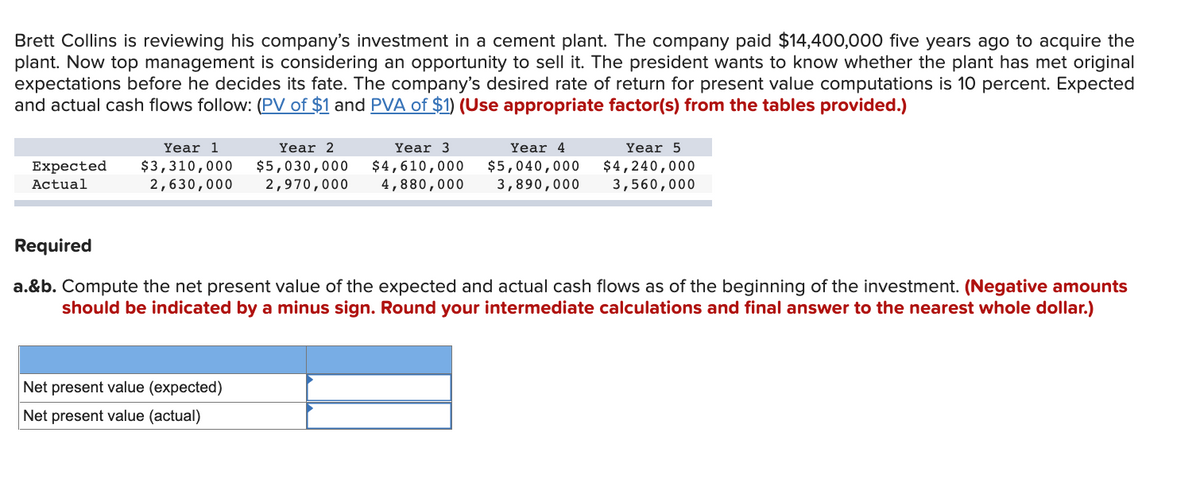ett Collins is reviewing his company's investment in a ceme ant. Now top management is considering an opportunity to kpectations before he decides its fate. The company's desire nd actual cash flows follow: (PV of $1 and PVA of $1) (Use appi Year 1 Year 2 Year 3 Yea Expected $3,310,000 $5,030,000 $4,610,000 $5,04C
ett Collins is reviewing his company's investment in a ceme ant. Now top management is considering an opportunity to kpectations before he decides its fate. The company's desire nd actual cash flows follow: (PV of $1 and PVA of $1) (Use appi Year 1 Year 2 Year 3 Yea Expected $3,310,000 $5,030,000 $4,610,000 $5,04C
Cornerstones of Cost Management (Cornerstones Series)
4th Edition
ISBN:9781305970663
Author:Don R. Hansen, Maryanne M. Mowen
Publisher:Don R. Hansen, Maryanne M. Mowen
Chapter19: Capital Investment
Section: Chapter Questions
Problem 10E: Roberts Company is considering an investment in equipment that is capable of producing more...
Related questions
Question

Transcribed Image Text:Brett Collins is reviewing his company's investment in a cement plant. The company paid $14,400,000 five years ago to acquire the
plant. Now top management is considering an opportunity to sell it. The president wants to know whether the plant has met original
expectations before he decides its fate. The company's desired rate of return for present value computations is 10 percent. Expected
and actual cash flows follow: (PV of $1 and PVA of $1) (Use appropriate factor(s) from the tables provided.)
Year 1
Year 2
Year 3
Year 4
Year 5
$3,310,000
2,630,000
$5,030,000
2,970,000
$4,610,000
4,880,000
$5,040,000
3,890,000
$4,240,000
3,560,000
Expected
Actual
Required
a.&b. Compute the net present value of the expected and actual cash flows as of the beginning of the investment. (Negative amounts
should be indicated by a minus sign. Round your intermediate calculations and final answer to the nearest whole dollar.)
Net present value (expected)
Net present value (actual)
Expert Solution
This question has been solved!
Explore an expertly crafted, step-by-step solution for a thorough understanding of key concepts.
Step by step
Solved in 2 steps with 1 images

Knowledge Booster
Learn more about
Need a deep-dive on the concept behind this application? Look no further. Learn more about this topic, accounting and related others by exploring similar questions and additional content below.Recommended textbooks for you

Cornerstones of Cost Management (Cornerstones Ser…
Accounting
ISBN:
9781305970663
Author:
Don R. Hansen, Maryanne M. Mowen
Publisher:
Cengage Learning

Managerial Accounting
Accounting
ISBN:
9781337912020
Author:
Carl Warren, Ph.d. Cma William B. Tayler
Publisher:
South-Western College Pub

EBK CONTEMPORARY FINANCIAL MANAGEMENT
Finance
ISBN:
9781337514835
Author:
MOYER
Publisher:
CENGAGE LEARNING - CONSIGNMENT

Cornerstones of Cost Management (Cornerstones Ser…
Accounting
ISBN:
9781305970663
Author:
Don R. Hansen, Maryanne M. Mowen
Publisher:
Cengage Learning

Managerial Accounting
Accounting
ISBN:
9781337912020
Author:
Carl Warren, Ph.d. Cma William B. Tayler
Publisher:
South-Western College Pub

EBK CONTEMPORARY FINANCIAL MANAGEMENT
Finance
ISBN:
9781337514835
Author:
MOYER
Publisher:
CENGAGE LEARNING - CONSIGNMENT

Intermediate Financial Management (MindTap Course…
Finance
ISBN:
9781337395083
Author:
Eugene F. Brigham, Phillip R. Daves
Publisher:
Cengage Learning

